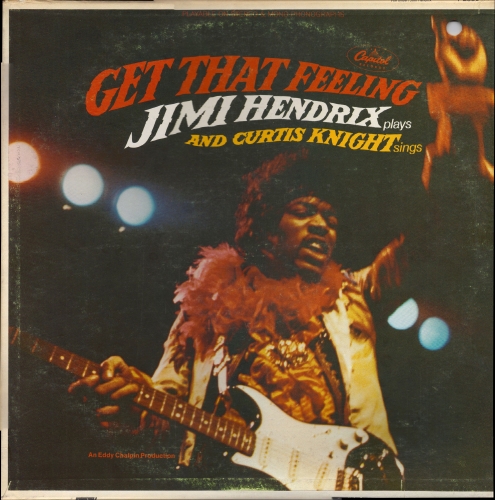

Jimi Hendrix & Curtis Knight ?– Get That Feeling
Label:
Capitol Records ?– T-2856
Format:
Vinyl, LP, Album
Country:
US
Released:
1967
Genre:
Rock
Style:
Psychedelic Rock
Tracklist Hide Credits?
A1 How Would You Feel 3:11
A2 Simon Says 3:14
A3 Get That Feeling
Written-By – Curtis Knight, Ed Gregory
10:02
B1 Hush Now 3:15
B2 Welcome Home 3:34
B3 Gotta Have A New Dress 3:03
B4 No Business 2:27
B5 Strange Things 2:56
Companies etc?
Manufactured By – Capitol Records, Inc.
Credits?
A&r [Coordination] – Nick Venet
Producer – Ed Chalpin
Written-By – Curtis Knight
review
[-] by Richie Unterberger
Before Jimi Hendrix went to London to become a solo recording star, he had recorded some material with journeyman soul singer Curtis Knight and signed a contract with record executive Ed Chalpin. When Hendrix became an international superstar in 1967, this contract backfired on him badly, as Chalpin leased recordings of the Knight sessions to Capitol Records that did not in any way reflect what Hendrix had evolved into as a solo artist. Eight of these tracks were issued at the end of 1967 on Get That Feeling, which -- despite featuring only a picture of Hendrix, in all his 1967 glory, on the cover -- only features him as a guitarist session man, with Knight actually handling the vocals. It was not clear exactly when this material was recorded (there are no liner notes), but likely it dated from mid-'60s sessions shortly before Hendrix went solo, and/or jam sessions never intended for release. It was the beginning of contractual headaches for Hendrix and his managers vs. Chalpin that would last for the rest of Hendrix's life. Its controversy also helped ensure that in Hendrix histories, the music on the album itself is overlooked and rarely discussed in depth. It's actually listenable, although generic, 1960s soul/R&B/rock, with Hendrix playing well but much more conventionally than he did on his own recordings. You can hear hints of his full-blown psychedelic style, as on the wah-wah effects on "Hush Now," while "How Would You Feel" is an obvious rewrite of Bob Dylan's "Like a Rolling Stone." The recording quality and mix, even by 1967 standards, isn't that good, although it's not truly terrible. If this had only come out as a bootleg years after Hendrix's death, it would probably be considered an interesting artifact, if of somewhat limited appeal to most listeners. As an entry into Hendrix's legitimate discography, though, it has to be considered peripheral at best, exploitative and unrepresentative of his music at worst.